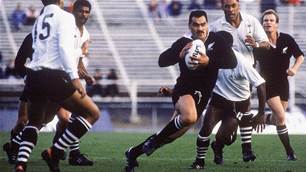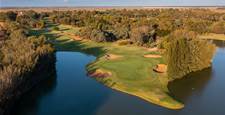The term ‘hidden gem’ is so often overused by golf scribes when reviewing a course. I know I have been guilty of it from time-to-time but I promise from now on that will change because this is a tale about a genuine golfing gem of the hidden variety.
The Forster-Tuncurry Golf Club, on NSW’s mid-north coast, boasts two golf courses. There is a short enjoyable course laid across gently sloping land outside the huge club building. This is the Forster course. Lying some seven kilometres away, to the north, is the club’s other layout. The Tuncurry Course, which is clearly one of the best five courses you will find between Newcastle and the Queensland border.
It is a gem … and it is hidden. While the signage off the main road through Tuncurry has improved over the past few years, it is still possible to miss the turn off (to the right if you’re heading north). Then, within a couple of hundred metres, buildings give way to scrub and you get the sense to ask yourself straight away, “Is this the right way?” Yes, it is the right way.
It doesn’t seem that long ago that this entry road was a dirt and gravel, which I once wondered whether that was by design to keep the masses from the door.
Why would anyone want to do that? Simple, the golf course here is a cracker and I can imagine there would be some locals who like the serenity and the course to themselves as much as possible.
Tuncurry is always lots of fun to play and the natural landscape here, combined with the wind, ensures no two rounds are ever the same.

The Kel Nagle and Mike Cooper designed layout was opened in 1984, less than a year after merging with the Forster Tuncurry Golf Club. The idea for the club came from a meeting of Forster Tuncurry members who met and formed the Great Lakes club. When finances started to run low, and without income provided by a clubhouse, the two clubs merged. Laid out on rolling sand dune terrain just a short pitch from Nine-Mile Beach, each hole is relatively isolated and has been carved from thick ti tree, gums, banksias and melaleucas.
Several holes had me thinking this par-72 course would not be out of place on the Melbourne Sandbelt. It boasts well-manicured bentgrass greens and rolling, tightly cut couch fairways that drain easily through the sand base below. On the autumn day I visited for the purpose of this story, the greens were firm and speedy while the fairways were also hard and fast. It was a links paradise with the best results coming from bouncing shots into the flags.
Most of the holes run predominantly north-south, so the fairways tend to run parallel with the dunes, at least until a dogleg left or right takes the fairway up and over a gentle dune. The 315-metre par-4 2nd, is a fine example, where the fairway covers the valley between two low-lying dunes for the first 200 metres before the hole turns markedly left, over a dune, and down before reaching the green.

A round at Tuncurry is more than just the golf. Dozens of birdlife varieties – including lorikeets, honeyeaters, kookaburras, butcherbirds and bowerbirds – call the course home, attracted by the nectar available in the banksias, eucalypts, grevilleas and callistemons here.
Tuncurry’s course staff have done a wonderful job to improve the course in recent years by clearing plenty of the undergrowth and some intrusive trees that used to line some holes. At one stage some of the fairways looked so narrow and intimidating, but this has changed and there is now plenty of width available for most tee shots, creating a greater number of playing lines into greens.
With this in mind, the par-4 6th is a beauty. The 332-metre hole features one of the widest fairways at Tuncurry but, standing on the tee, you have to work out whether you want to approach the green from the left or right because the fairway runs along the top of dune for most of the journey, making the high point the centre of the fairway. Miss the narrow green left or right and a good up-and-down is required to save par.

One of the most memorable holes at Tuncurry is also the only one that runs from east to west across the dunes. The 439-metre par-5 15th (which can be stretched to 479 metres) is typical of what can be found across the entire layout – rolling couch fairway, thick Banksia rough and a chance to make a good score if you can get your drive in the right spot on the fairway. The fairway bunker left catches any player trying to skirt the corner of the dogleg, while there are two more fairway bunkers through the corner on the right. Longer hitters can take on the corner; a draw around the corner is ideal, while the rolling fairway tests your mettle heading into the green.
It’s not surprising to me that a series of subtle improvements in recent times have helped Tuncurry to continue to climb higher in this magazine’s Top-100 Public Access Courses ranking, having reached No.77 in Australia in 2023, up six places from its 2021 position.
“I love this golf course. It’s a simple design across rolling sandy terrain, which has been made even better in recent years with some smart vegetation management,” Top-100 judge Lucas Andrews said.

Fellow judge Alex Georgiou added: “Tuncurry is a course with enormous potential. It already boasts a terrific routing, wonderful natural design and a beautiful setting to play the game. You can’t ask for much more than that.”
Tuncurry can achieve an even higher position in the public access ranking in years to come. I think the key is keeping the simplicity and beauty of the Nagle and Cooper design, while ensuring its links traits are maintained. So far so good.
FACT FILE
 LOCATION: Northern Parkway, Tuncurry, NSW
LOCATION: Northern Parkway, Tuncurry, NSW
CONTACT: (02) 6554 6799 (pro shop)
WEBSITE: www.forstertuncurrygolf.com.au
DESIGNERS: Kel Nagle and Mike Cooper (1984).
PGA PROFESSIONALS: Craig Stickling, Nathan Dorahy.
GREEN FEES: $59 (18 holes).
ACCOLADES: Ranked No.77 in Golf Australia magazine’s Top-100 Public Access Courses for 2023.
Related Articles

International Spotlight: Omanu Golf Club

Celebrity Kiwi couple tee off in paradise












